Khao Yai National Park, Thailand

Thailand’s oldest national park is a popular weekend retreat for Bangkok residents, who enjoy the cool morning temperatures that its modest elevations bring. Though it has a reputation for large mammals, including elephants, its most conspicuous wildlife consists of macaques, gibbons, and two spectacular hornbill species, Great and Wreathed. Visitors who take the time to explore its trails and less-traveled roadways can find a wealth of diversity, including large mixed flocks of maddeningly similar Phylloscopus leaf warblers, and have a reasonable chance of finding one or more of the park’s avian star attractions: Silver Pheasant, Siamese Fireback, Coral-billed Ground-Cuckoo, and Eared Pitta.
Orientation
Directions
Khao Yai National Park is about two and a half hours’ drive (150 km) northeast of downtown Bangkok. There are two entrances—at the north and south ends of the main road through the park—both about equally convenient to reach from Bangkok. There seems to be a general preference for the north entrance because it is much closer to the visitor center and other facilities, but the south entrance is closer to Bangkok.
North Entrance: Take any of the major freeways north out of the city to the area where they converge about 45 km from downtown, then take Route 1 north-northeast to Saraburi and exit onto Route 2 eastbound.
Stay on Route 2 for 36 km, then exit left onto Route 2089 northbound. After about 800 m, where Route 2089 splits, turn right to return southbound on Route 2089. You will pass over Route 2 again, then rejoin it westbound (toward Saraburi).
After returning 1.2 km exit onto Route 1016, go 3.5 km and turn left to remain on Route 1016. The road will make a few turns in quick succession. Then turn right to remain on Route 1016 for another 21 km.
Upon reaching the village of Mu Si, turn right onto Route 2090. After 3.3 km this road reaches the north entrance gate and becomes the main road through the park.
South Entrance: Begin northbound on the Chalong Rat Expressway, which merges into the Route 9 freeway just north of the Safari World theme park. After another 6 km, exit onto Route 305 (the main highway from Rangsit to Nakhon Nayok) eastbound, then stay on this road for approximately 62 km to Nakhon Nayok, where it merges into Route 33 eastbound.
Remain on Route 33 for 20 km and turn right onto Route 3077. After 11.5 km this road reaches the south entrance gate and becomes the main road through the park.
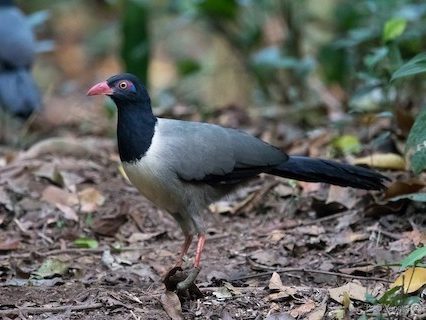
Khao Yai National Park is one of the best places to find the Coral-billed Ground-Cuckoo. © Pattaraporn Vangtal
Birdfinding
Khao Yai National Park is a large area that is challenging for the first-time visitor to explore effectively. The main road through the park is a straightforward north-south corridor, which can be joined from either end, but it connects to a network of roads, trails, campgrounds, and administrative facilities, and many restricted areas.
Khao Yai is a large geographical feature, an uplift or sierra that extends for approximately fifty miles east-to-west, and is approximately twenty miles wide along much of its length. The national park covers most of the uplift, and the area of the park that is accessible to visitors is mainly limited to the central plateau.

Silver Pheasant at Khao Yai National Park. © Laurie Ross

For birds, there are four areas of primary interest, from north to south: (1) Km 33; (2) the Visitor Center area, including the Dong Tiew – Sai Sorn Reservoir Trail; (3) Pha Gluay Mai Campground and the trail from there to Haew Su Wat Waterfall; and (4) the Khao Khieo Road. Two additional areas near each of the park entrance gates are of more marginal interest: (5) Haew Narok Waterfall, near the south entrance; and (6) Mu Si, just outside the north entrance.
Km 33. After entering the park from the north, the road climbs for about 5 km to reach the plateau. At Km 33, shortly before the road levels off, there is a small parking area and trailhead on the western side of the road.

Blue Pitta. © Bruce Wedderburn
This trail winds back into the forest, then passes through semiopen woodland, then a large meadow, then beside a pond and observation tower, and ultimately arrives at the main road at around Km 35.
From the trailhead you can explore the forest by trail or by walking up or down the road (traffic permitting). The trail is extremely twisty and poorly marked, but passable and most productive up to the edge of the large meadow. Resident birds in the area include: Scaly-breasted Partridge, Siamese Fireback, Great, Wreathed, and Oriental Pied Hornbills, several species of woodpecker, Blue and Eared Pittas, and Dusky, Banded, Long-tailed Broadbills.
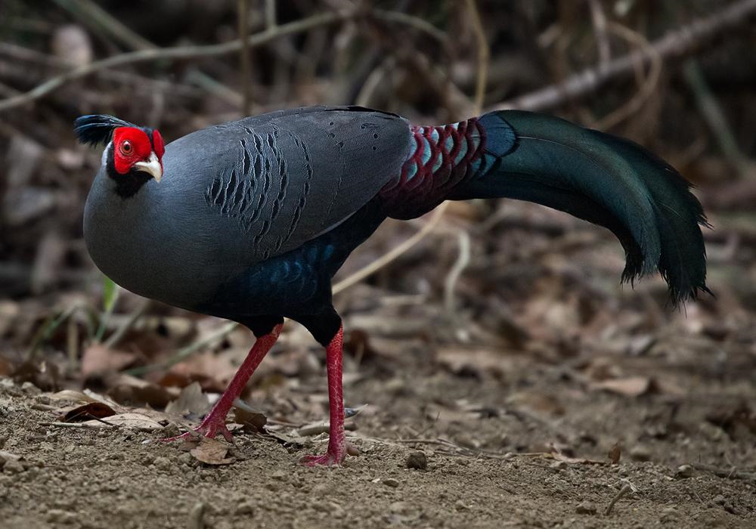
Khao Yai National Park is one of the best places to find the Siamese Fireback. © Lars Petersson

Visitor Center. The visitor center and park headquarters area is a popular stopping point, but not especially productive for birds. Beside the center is a slough with a suspension bridge that is the beginning of a short loop trail through forest with dense bamboo undergrowth. Most of the species found at Km 33 also occur here, but are seen less often.
About 200 m south of the visitor center is a short access road to the east that leads to a few buildings and is a convenient place for a stroll with good lines of sight into the open canopy. Brown Hornbill often appears here, along with Green-eared, Moustached, and Blue-eared Barbets.

Brown Hornbill at Khao Yai National Park. © Ayuwat Jearwattanakanok
Dong Tiew – Sai Sorn Reservoir Trail. Directly across the main road from the visitor center is the Dong Tiew trail, which goes through productive forest, but can be messy and challenging to hike. After about 1.5 km the trail forks. To the left is a long route to the observation tower and Km 33 trail.
To the right the trail goes to Sai Sorn Reservoir. Soon after the first fork, the trail forks again: going left will take you to the north end of the reservoir, rejoining the main road about 800 m south of the visitor center; the right fork leads to the south end of the reservoir, rejoining the main road about 1.5 km south of the visitor center.
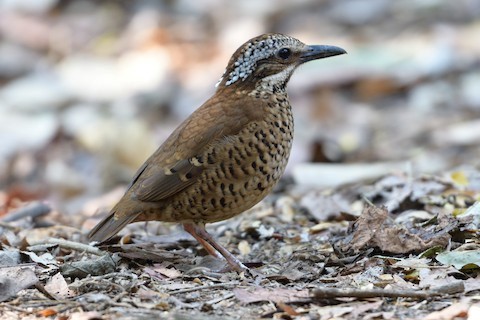
Eared Pitta. © Khemthong Tonsakulrungruang
The trail is known as a good place to find several forest interior birds, including Scaly-breasted Partridge, Red Junglefowl, Silver Pheasant, Siamese Fireback, Orange-breasted and Red-headed Trogons, Blue and Eared Pittas, and White-crowned Forktail. Near the north end of the reservoir is a side trail that is especially good for Eared Pitta.
Pha Gluay Mai Campground. The smaller and quieter of the park’s two campgrounds is a traditional spot for birdwatching tour groups to eat lunch and relax in the midday heat. There are many flowering and fruiting trees that can attract a wide variety of colorful birds, including Thick-billed Green-Pigeon, Scarlet Minivet, Common Green-Magpie, Asian Fairy-Bluebird, Yellow-vented and Fire-breasted Flowerpeckers, and Little Spiderhunter.

Orange-breasted Trogon is common at Khao Yai National Park. © David Diller
The campground has two camping areas: one on the east side of the road, south of the campground store, and the other on the west side of the road, north of the store. On the western side of the northern camping area, at the edge of the forest, are two sets of washrooms, and just downhill from the southern washroom (but accessed by a short trail closer to the northern washrooms) is a moist depression in the woods that is known as a stakeout for certain forest interior birds, including Coral-billed Ground-Cuckoo, Blue Pitta, Orange-headed Thrush, Siberian Blue Robin, and White-rumped Shama—although the cuckoo and pitta have become infrequent over the years.
The road beyond the campground goes about 4 km to Haew Su Wat Waterfall, climbing through forest that can be productive for a wide array of birds including trogons, hornbills, woodpeckers, and broadbills. The gate above the campground is open from early morning to 17:00.
Trail to Haew Su Wat Waterfall. An alternative walking route from Pha Gluay Mai Campground to Haew Su Wat Waterfall is a trail that begins at the eastern end of the southern parking area, beside the campground store. The trail is about 4 km and somewhat challenging to hike, but possibly the most productive accessible area in the park—of particular interest to many visitors, it appears to be the most consistent place to find Coral-billed Ground-Cuckoo.

Coral-billed Ground-Cuckoo at Pha Gluay Mai. © Alex Vargas
Khao Khieo Road. On the east side of main road about 4 km south of the visitor center are two junctions about 300 m apart. The northern road goes to Pha Gluay Mai Campground and Haew Su Wat Waterfall (above). The southern road goes to the highest peak in the park, Khao Khieo. A military observatory occupies the highest part of Khao Khieo, and a gate blocks unauthorized access to that area, but the accessible portion is worth visiting both for the scenic views and for some productive habitat.
The road is mostly level for about 5 km, passing through humid forest with a large meadow in the middle, then it climbs steeply through a set of long switchbacks, then it reaches a saddle and the ridgeline up to the crest of Khao Khieo. Shortly before the crest is a short loop trail, Pha Diew Dai, which is a raised boardwalk through the forest that includes a stunning view from the top of a cliff.
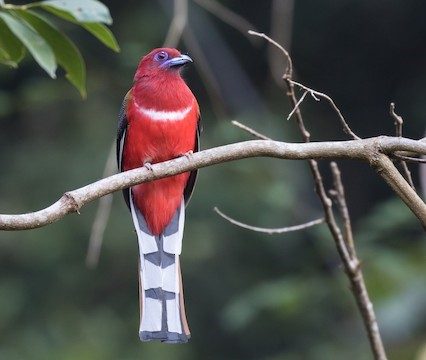
Red-headed Trogon is common at Khao Yai National Park. © Frans Butler
Silver Pheasant, Red-headed Trogon, and Blyth’s Shrike-Babbler are often found along the trail and can also be found along the road. This part of the park generally receives fewer visitors than the main plateau, so the road is often peaceful and can be productive walking—especially the switchback section and the lower forested areas on either side of the large meadow. Black Eagle and Mountain Hawk-Eagle are regularly seen soaring over the steep, rugged terrain.
Haew Narok Waterfall. After entering the park from the north, the road climbs for about 10 km to reach the plateau. Around this point, you reach the first developed site, Haew Narok, accessed by a short side-road to the west.
The short trail to the waterfall goes through productive forest where several species of flowerpeckers (Thick-billed, Yellow-vented, Fire-breasted, and Scarlet-backed) and sunbirds (Ruby-cheeked, Brown-throated, Van Hasselt’s, Olive-backed, and Crimson) and Little Spiderhunter can sometimes be found. (Note that the trail closes at 17:00.)

Crimson Sunbird. © Neoh Hor Kee
Mu Si. About 3.5 km north of the north entrance to Khao Yai, in the village Mu Si, the main road bends broadly 90 degrees from north-south to east-west. Two sites near this bend are notable: a bat-watch and the grounds of the district government office.
To reach the bat-watch, go 3 km north of the entrance gate and turn west into a small neighborhood of country homes situated around a pond. After 500 m this road forks—here it becomes a loop around the pond. Taking either fork, drive another 500 m to the far side of the pond, then turn onto the small road, proceed about 200 m, and park.
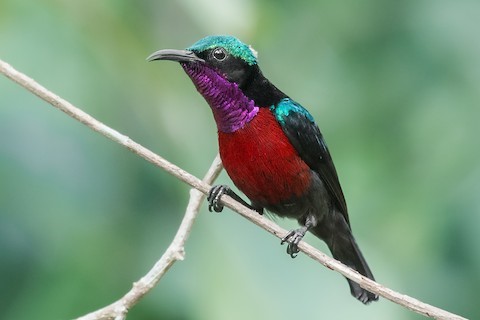
Van Hasselt’s Sunbird. © Natthaphat Chotjuckdikul
Looking south into the hills in the late afternoon, you will see a multitude of bats streaming out of a cave to disperse over the landscape to feed for the night. Shikras and sometimes other raptors attend this event to pick off a few of the bats.
To reach the Mu Si district office, continue around the bend to the east. About 4 km from the entrance gate (i.e., 1 km from the turn-off to the bat-watch), turn south and park at the district office. Red-breasted Parakeet and Black-collared Starling can often be found by walking the grounds.

Fire-breasted Flowerpecker. © Ayuwat Jearwattanakanok
Services
Accommodations
Within the park, Lam Ta Khong and Pha Gluay Mai Campgrounds are available for camping, and have restaurants, showers, and related facilities. There are no assigned sites and no specific limitations, but require payment of a nominal fee. If you have your own tent, you can simply set it up on an unoccupied patch of lawn. If you need to rent a tent and sleeping bags, they are available from the campground managers on a first-come-first-served basis. Birdwatchers who camp in the park tend to choose Pha Gluay Mai because it is a destination in itself, and it is also the smaller and quieter of the two.
The park also has three sizes of bungalows available to rent: small ones for two people; mid-sized for eight people; and large ones for twenty people. The rental procedure is not convenient for foreigners, as it requires booking from within Thailand less than two days before occupancy begins and conducting a wire transfer payment from a Thai bank or 7-Eleven convenience store. For more detailed information about the procedure, see the Thai National Parks Department webpage: http://nps.dnp.go.th/reservation.php.
Outside the park entrance gates, both north and south, there are several hotels and resorts.
Food
For visitors who plan to stay overnight in the park, there is an important detail: you cannot leave the park just to have dinner, then re-enter to sleep. Food service is provided at several locations within the park, but it is best to bring some emergency rations in case the available services turn out to be incompatible with your plans.
There are small restaurants at both Lam Ta Khong and Pha Gluay Mai, but they are somewhat unreliable. On weekdays when there are very few patrons they sometimes close early, and on weekends they sometimes run out of food.
The visitor center area has two restaurants and a coffee shop which reportedly keep longer and more reliable hours than those at the campgrounds. Bear in mind, however, that conditions and services at Khao Yai may not be consistent from one year to the next—so it is unwise to rely on any information unless it is recently verified.
Food is also available outside the park entrance gates, both north and south, at hotels, resorts, restaurants, and convenience stores.
Notes
When to Visit
Khao Yai is Thailand’s most popular park, a fact that will really resonate with you if you visit on a weekend or during a major holiday—especially the two New Year’s periods: late December into early January and “Songkran” in the first half of April. If at all possible, schedule your visit to avoid these days.
The entrance gates are open daily from 6:00 to 18:00. The per-person fee for foreigners is 400 baht, and there is an additional per-vehicle fee. Payment is valid for multiple entries on the same day or to remain in the park for multiple days.
Hazards & Hassles
Large Dangerous Animals. Khao Yai has significant populations of large mammals that can be dangerous, especially Asian Elephant. As a general rule, wild elephants want no interaction with humans and they remain away from well-traveled areas during the day. From dusk to dawn, however, they wander more widely and often emerge, cross roads, and visit waterholes, which can lead to inadvertent encounters.
Most visitors would like to see a wild elephant, but chance sightings and encounters are rare. To find an elephant on purpose it is necessary to hire a guide with updated information on the daily habits and whereabouts of particular groups.
Leeches. During the wet season—roughly April through October—the forests at Khao Yai are rife with leeches. If you will be walking the trails at this time, wear “leech socks” and tuck your pants into them. Leech bites are not life-threatening and generally not painful, but they inject an anti-coagulant which makes the wounds bleed after they detach.
Cold. If you will be staying overnight at Khao Yai, bring extra layers of clothing. Despite the tropical heat that prevails during most of the day, the park cools off considerably.
Links